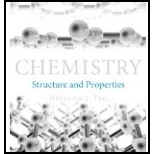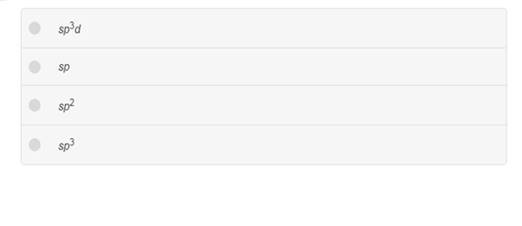
Determine the hybridization about 0 in CH3OH.

Interpretation:
Find the hybridization of Oxygen (O) in
Concept introduction:
For molecule with two or more than two atoms, the formation of hybrid orbital takes place by the mixing of atomic orbitals of atoms possessing nearly same energy in free state. The mixing of orbitals takes place by the overlapping of orbitals of each atom in the molecule, which result in the formation of bonds. The formed hybrid orbitals possess energies that are different from the energy of atomic orbitals of parent atoms. The hybrid orbitals which possess less energy compared to the atomic orbitals of parent atoms result in formation of sigma molecular orbitals whereas hybrid orbitals which possess more energy compared to the atomic orbitals of parent atoms result in formation of pi molecular orbitals.
Answer to Problem 1SAQ
Option (d) is the correct answer. Because, the Oxygen (O) hybridization of
Explanation of Solution
Reason for the correct option:
The electronic configuration of O:
The oxygen can form two bonds with this electronic configuration.
In
The hybridization of
Want to see more full solutions like this?
Chapter 7 Solutions
Chemistry: Structure and Properties
- What is the name of the following compound? SiMe3arrow_forwardK Draw the starting structure that would lead to the major product shown under the provided conditions. Drawing 1. NaNH2 2. PhCH2Br 4 57°F Sunny Q Searcharrow_forward7 Draw the starting alkyl bromide that would produce this alkyne under these conditions. F Drawing 1. NaNH2, A 2. H3O+ £ 4 Temps to rise Tomorrow Q Search H2arrow_forward
 Chemistry: Principles and PracticeChemistryISBN:9780534420123Author:Daniel L. Reger, Scott R. Goode, David W. Ball, Edward MercerPublisher:Cengage Learning
Chemistry: Principles and PracticeChemistryISBN:9780534420123Author:Daniel L. Reger, Scott R. Goode, David W. Ball, Edward MercerPublisher:Cengage Learning Chemistry: Principles and ReactionsChemistryISBN:9781305079373Author:William L. Masterton, Cecile N. HurleyPublisher:Cengage Learning
Chemistry: Principles and ReactionsChemistryISBN:9781305079373Author:William L. Masterton, Cecile N. HurleyPublisher:Cengage Learning Chemistry: The Molecular ScienceChemistryISBN:9781285199047Author:John W. Moore, Conrad L. StanitskiPublisher:Cengage Learning
Chemistry: The Molecular ScienceChemistryISBN:9781285199047Author:John W. Moore, Conrad L. StanitskiPublisher:Cengage Learning ChemistryChemistryISBN:9781305957404Author:Steven S. Zumdahl, Susan A. Zumdahl, Donald J. DeCostePublisher:Cengage Learning
ChemistryChemistryISBN:9781305957404Author:Steven S. Zumdahl, Susan A. Zumdahl, Donald J. DeCostePublisher:Cengage Learning Chemistry & Chemical ReactivityChemistryISBN:9781337399074Author:John C. Kotz, Paul M. Treichel, John Townsend, David TreichelPublisher:Cengage Learning
Chemistry & Chemical ReactivityChemistryISBN:9781337399074Author:John C. Kotz, Paul M. Treichel, John Townsend, David TreichelPublisher:Cengage Learning Chemistry & Chemical ReactivityChemistryISBN:9781133949640Author:John C. Kotz, Paul M. Treichel, John Townsend, David TreichelPublisher:Cengage Learning
Chemistry & Chemical ReactivityChemistryISBN:9781133949640Author:John C. Kotz, Paul M. Treichel, John Townsend, David TreichelPublisher:Cengage Learning





